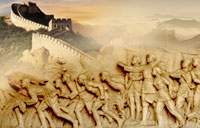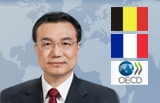Kids tell the story of science
By LIA ZHU in San Francisco (China Daily USA) Updated: 2015-04-16 11:18
 |
|
Winning students join James Reynolds (right), organizer of the technology timeline illustration competition and president of the Sunnyvale Historical Society, on April 10 at the Sunnyvale Heritage Park Museum, where the students' illustrations are on display. Lia Zhu/China Daily |
Try to imagine the evening when the inventor of the hot air balloon discovered hot air was lighter than cold air, or how the inventor of the helicopter was inspired by the ancient Chinese toy bamboo dragonfly.
Chinese-American teenagers in the San Francisco Bay Area were challenged to explore the history of technology by illustrating the stories and questions that triggered significant inventions in human history.
About 60 students from 5th t0 11th grades participated in the illustration competition that was aimed at stimulating their interest in technology and inspire them to think about becoming inventors and innovators themselves.
After months of research and preparation, the participants submitted nearly 100 pieces under the three themes of avionics, electronics and software by April 7, and 38 of them are being honored by being put on weeklong display at the Sunnyvale Heritage Park Museum in Sunnyvale in the heart of Silicon Valley.
The idea first came to Sue Chen, co-organizer of the competition, when she saw the "technology timeline wall" at the Mecum.
"The descriptions of the inventions are quite boring to children," said Chen, who is CEO of StoryRobin, a Bay Area-based publisher focused on Children's education. "I came up with the idea of digitalizing the wall by turning it into an iBook with illustrations done by kids."
"They (the students) were not just googling images but actually did in-depth research," she said. "Some of them have gotten a better understanding of ancient China's contribution to the world's technological development."
In one of the illustrations, Kelly Lu, a six-grader at Challenger School in Berryessa, depicted upward flying bamboo copters surrounded with gears, indicating the industrial application of the theory behind the ancient Chinese toy, also known as a bamboo dragonfly. The gadget was invented about 2,400 years ago and was the object of early experiments by Englishman George Cayley, one of the pioneers of modern aeronautics.
Lu said she had seen plastic "bamboo copters" before but never knew they originated in China until she did her research.
"My piece highlights China's impact on aerodynamics in the present day. I want others to see the strength of this simple item that originated from China so long ago," she said. "As a Chinese American, I feel proud of China's long and rich history. Through my drawing, I hope that other people, children and adults alike, can appreciate the significance of this toy in aviation and have fun."
Yilin Huang, 12, another contestant, created an abstract illustration with overlapping images of a Jacquard loom and a player piano.
"I play piano myself but I had never thought the player piano could be connected to a loom," said Huang, a student at Olivera Elementary School. "After researching it, I found out that the Jacquard loom is connected with many modern inventions."
The Jacquard loom used punched cards to control the sequencing of a loom, one of the early examples where the work of a machine was controlled by "software". This technology was used in player pianos, which play by themselves.
"It is a significant invention in computation because the machine can run automatically," she said.
To help the students learn about avionics and electronics, James Reynolds, organizer of the competition and president of the Sunnyvale Historical Society, demonstrated the experiments himself at a local studio where the students received training.
One of his experiments was to use a hair dryer and a ping-pong ball to demonstrate Bernoulli's principle which determines that the sideways vacuum pressure created by rapid air flow makes airplane wings lift.
Reynolds, who was an engineer at Fairchild Semiconductor, one of the earliest tech companies in Silicon Valley, said all the 38 illustrations will be put into the second part of the book Technology Timeline iBook, which will be released later this year. The first part of the book, on computation, published last year, features about 240 pieces of artwork by students from fourth to seventh grades.
liazhu@chinadailyusa.com






